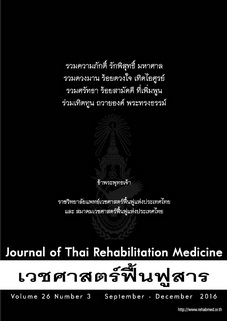ผลการรักษาเด็กสมองพิการด้วยวิธีวอยตาต่อการเดิน
ผลการรักษาเด็กสมองพิการด้วยวิธีวอยตาต่อการเดิน
Keywords:
Vojta therapy, Gait, Cerebral palsyAbstract
Objectives: To evaluate the effect of Vojta therapy on gait in children with cerebral palsy
Study Design: Cohort study
Setting: Srisangwan School
Subjects: Cerebral palsy children aged 7-12 years old
Methods: Every child received 3 sessions of 30 minutes Vojta therapy per week for 8 weeks. Temporal spatial gait parameters were assessed with TailGaitTM device. Walking ability was assessed with Expanded Time Get-Up-and-Go test (ETGUG) and Six-Minute Walk test (6MWT). The assessment was done before therapy, 4th week, 8th week after therapy begin and 4th week after the therapy was stopped.
Results: Twenty children with mean age of 9.8 years old were recruited. Twelve of these (60%) are GMFCS level 4. The average 6MWT scores before therapy, 4th week, 8th week after therapy begin and 4th week after the therapy ended were 78.68, 96.6, 108.65 and 69.91 meters respectively. Double Support Time (DST) before therapy, 4 weeks, 8 weeks after therapy begin and 4th week after the therapy ended were 53.5, 48.15, 42.18 and 43.54 respectively. The differences of 6MWT and DST scores between before and after 8 weeks of Vojta therapy were statistically significant (P<0.05). The average 6MWT score after 4th week of no therapy was significantly lower than the score measured at the end of the 8th week therapy (P<0.05).
Conclusion: An 8-week Vojta therapy could increase distanceof the 6-Minute Walk Test and decrease double support time of school age children with cerebral palsy.
References
2. Franki I, Desloovere K, De Cat J, Feys H, Molenaers G, Calders P, el al. The evidence base for conceptual approaches and additional therapies targeting lower limb function in children with cerebral palsy: a systematic review using the international classification of functioning, disability and health as a framework. J Rehabil Med. 2012;44: 396-405.
3. Ketelaar M, Vermeer A, Hart H, van Petegem-van Beek E, Helders PJ. Effects of a functional therapy program on motor abilities of children with cerebral palsy. Phys Ther. 2001;81:1534-45.
4. Sirindhorn National Medical Rehabilitation Centre. Vojta therapy in childhood. Bangkok: Department of Medical Services, Ministry of Public Health; October 2556.
5. Valouchova P, editor. Benefits and limitations of Vojta’s approach of reflex locomotion. Presentation for International Conference Neurorehabilitation Principles; 2008 November 14-15, Available from http://www.Rehabps.com.
6. Kanda T, Pidcock FS, Hayakawa K, Yamori Y, Shikata Y. Motor outcome differences between two groups of children with spastic diplegia who received different intensities of early onset physiotherapy followed for 5 years. Brain & Development. 2004;26:118-126.
7. Lim H, Kim T. Effects of Vojta therapy on gait of children with spastic diplegia. J Phys Ther Sci. 2013;25:1605-08.
8. Gajewska E, Neukirch B. Vojta therapy for 12 years old child with cerebral palsy. J Phys Ther Sci. 2012;24:783-5.
9. Wall JC, Bell C, Campbell S, Davis J. The time get up and go revisited: Measurement of the component tasks. J Rehabil Res Dev. 2000;37:109-114.
10. Rosenbaum PL, Walter SD, Hanna SE, Palisano RJ, Russell DJ, Raina P, el al. Prognosis for gross motor function in cerebral palsy. JAMA. 2002;288:1357-63.
11. American thoracic society. ATS Statement:Guideline for the Six-Minute Walk Test. Am J Respir Crit Care Med. 2002; 166: 111-7.
12. Nsenga LA, Shephard RJ, Ahmaidi S. Six-minute walk test in children with cerebral palsy gross motor function classification system level I and II: reproducibility, validity, and training effect. Arch Phys Med Rehabil. 2012;93: 2333-9.
13. Palisano R, Rosenbaum P, Walter S, Russell D, Wood E, Galuppi B. Development and reliability of a system to classify gross motor function in children with cerebral palsy. Dev Med Child Neurol. 1997;39: 214-23.






